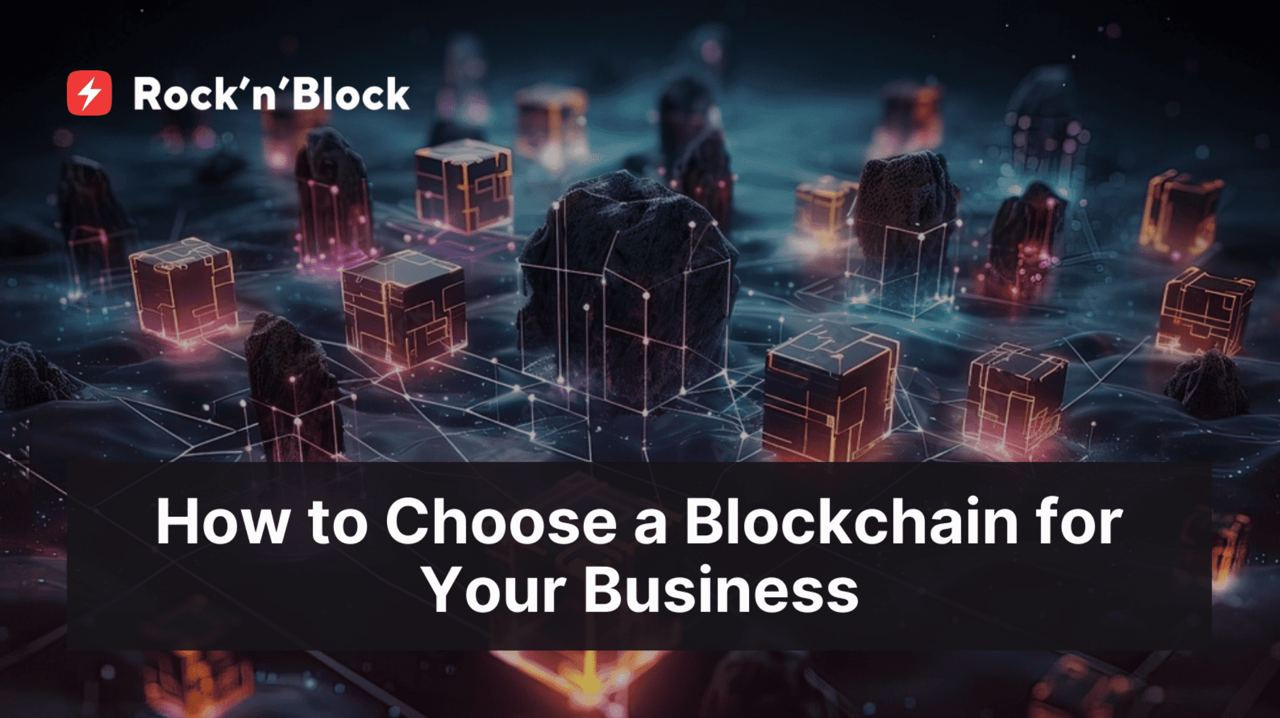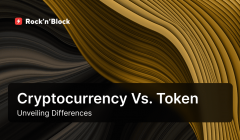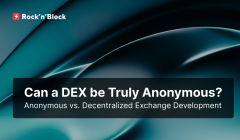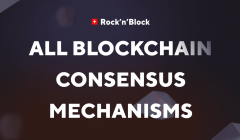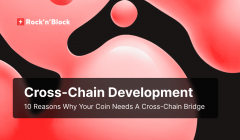How to choose a blockchain platform for your business?
23 Jul 2021In the ever-evolving landscape of technology, blockchain development has gained significant prominence. Businesses across various industries are exploring the potential of blockchain technology to enhance their operations, from supply chain management to smart contracts. However, choosing the right blockchain platform is a critical decision for successful blockchain project development. In this article, we'll delve into the key considerations when selecting a blockchain for your business.
Table of Contents:
-
Understanding Your Use Case
-
Types of Blockchain: Public, Private, or Consortium
-
Deploying your own blockchain Vs Building on the existing
-
Security and Consensus Mechanisms
-
Scalability Matters
-
Smart Contract Support
-
Cost and Pricing
-
Other Considerations
Understanding Your Use Case
Before delving into the world of blockchain, it's essential to define your use case. What specific problem do you intend to solve with blockchain technology, and how does it align with your overall business strategy?
Types of Blockchain: Public, Private, or Consortium
Blockchain platforms come in different flavors, including public, private, and consortium blockchains. Public blockchains like Ethereum and Bitcoin are open to anyone, while private blockchains are restricted to authorized participants. Consortium blockchains are shared among multiple organizations. Choose the type that best suits your project's requirements.
Public Blockchains
Public blockchains are open to anyone and are entirely decentralized. Some well-known examples include Ethereum and Bitcoin. These are ideal for projects that require transparency and security without relying on a central authority.
Private Blockchains
Private blockchains are restricted to authorized participants, making them suitable for projects where privacy and control are paramount. Businesses often use private blockchains to streamline internal operations, supply chain management, and data sharing.
Consortium (or Hybrid) Blockchains
Consortium blockchains combine elements of both public and private blockchains. Multiple organizations jointly control the network, providing a balance between transparency and control. This type is suitable for industries like healthcare, finance, and logistics, where multiple stakeholders need to collaborate securely.
Permissioned Blockchains
Permissioned blockchains grant access only to authorized users. They are commonly used in enterprise applications, offering a high level of control and security. Projects requiring strict governance and compliance often opt for permissioned blockchains.
Deploying your own blockchain Vs Building on the existing
Building Your Own Blockchain
If you are creating a blockchain from the ground up, you have the flexibility to design and implement your custom consensus mechanism. Consider factors such as performance, security, and decentralization. Common consensus mechanisms for custom blockchains include Proof of Work (PoW), Proof of Stake (PoS), Delegated Proof of Stake (DPoS), and more. Analyze the specific needs of your project to make the right choice.
Developing on an Existing Blockchain
When developing a project on an existing blockchain, you must adhere to the consensus mechanism already in place on that blockchain. For example, Ethereum uses PoW, while Cardano employs PoS. Understand the strengths and limitations of the chosen blockchain's consensus mechanism and ensure it aligns with your project's requirements.
Security and Consensus Mechanisms
A consensus mechanism is a crucial component of a blockchain network. It's a set of rules or protocols that enable nodes (participants) in a distributed network to agree on the validity of transactions and achieve a common, immutable ledger. Consensus mechanisms are essential for maintaining the integrity and security of the blockchain.
There are several different consensus mechanisms, each with its own characteristics and advantages. Here are some of the most well-known ones:
Proof of Work (PoW)
This is the consensus mechanism used in Bitcoin. In a PoW system, miners compete to solve complex mathematical puzzles, and the first one to solve it gets the right to add a new block to the blockchain. PoW is known for its security but is energy-intensive.
Proof of Stake (PoS)
In a PoS system, validators are chosen to create new blocks and validate transactions based on the number of cryptocurrency tokens they hold and are willing to "stake" as collateral. PoS is more energy-efficient compared to PoW.
Delegated Proof of Stake (DPoS)
DPoS is a variation of PoS where a smaller group of delegates, elected by the network, is responsible for validating transactions and creating blocks. It's faster and more scalable but potentially less decentralized.
Proof of Authority (PoA)
In a PoA system, nodes are known and reputable validators or authorities. They take turns creating blocks, and malicious activity is deterred by the reputation of validators.
Proof of Space and Time (PoST)
This mechanism uses storage space and time as the basis for reaching consensus. Validators prove they have allocated a certain amount of storage space and held it for a specified period.
Proof of History (PoH)
PoH is used in conjunction with other consensus mechanisms like PoS. It provides a historical record of events, helping nodes agree on the order of transactions.
Tangle (Used in IOTA)
IOTA uses a Directed Acyclic Graph (DAG) instead of a traditional blockchain, and transactions are validated by confirming other transactions. This eliminates miners and transaction fees.
The choice of consensus mechanism depends on the specific goals, use case, and requirements of a blockchain project. Each mechanism has its advantages and trade-offs in terms of security, scalability, energy efficiency, and decentralization. Therefore, it's essential to carefully consider which consensus mechanism is most suitable for the intended blockchain application.
For further in-depth reading on blockchain consensus mechanisms, you may find the following source helpful: Full Guide about All Blockchain Consensus Mechanisms
This comprehensive guide provides detailed information about various consensus mechanisms used in blockchain technology, offering a valuable resource for those looking to deepen their understanding of this critical aspect of blockchain development.
Scalability Matters
Scalability is a crucial factor in the choice of a blockchain for blockchain development for several reasons:
Handling Increased Transaction Volume
As a blockchain network gains more users and usage, the transaction volume on the network increases. A scalable blockchain can process a higher number of transactions per second, ensuring that it can accommodate the demands of a growing user base. This is especially important for businesses that anticipate significant growth in their user base and transaction activity.
Maintaining Performance
Scalability is closely tied to the performance of a blockchain. A scalable blockchain can maintain efficient performance, ensuring that transactions are confirmed quickly and that the network remains responsive. In contrast, a non-scalable blockchain might experience bottlenecks and delays, which can frustrate users and hinder the adoption of blockchain-based applications.
Reducing Transaction Costs
In a scalable blockchain, transaction fees are typically lower because there is more capacity to process transactions. Lower transaction fees are beneficial for businesses and users, as they reduce the cost of using the blockchain and make it more competitive with traditional payment systems.
Supporting Diverse Use Cases
Scalability is essential for supporting a wide range of use cases. Some applications require a high throughput of transactions, such as payment systems or supply chain management. Others might need to handle complex smart contracts or large data storage. A scalable blockchain can accommodate these varied use cases, making it versatile for different applications.
Enhancing User Experience
Users have come to expect smooth and seamless experiences from blockchain-based applications. Scalability contributes to a positive user experience by ensuring that transactions are processed quickly and that applications are responsive. A lagging or congested blockchain can lead to a frustrating user experience, potentially causing users to abandon the platform.
Attracting Developers and Businesses
Developers and businesses are more likely to choose blockchain platforms that offer scalability. A scalable blockchain is seen as more attractive because it allows developers to build applications that can handle a growing number of users and transactions. This, in turn, encourages ecosystem growth and partnerships.
Competing in the Market
The blockchain space is highly competitive, with various platforms vying for attention and adoption. Scalability is a critical feature that can set a blockchain apart from the competition. Projects that can demonstrate high scalability are better positioned to attract users and developers.
Meeting Future Growth
Scalability isn't just about addressing current demands; it's also about preparing for future growth. As businesses expand and evolve, their blockchain infrastructure needs to adapt and scale accordingly. A scalable blockchain provides the flexibility to meet future demands without having to undergo major overhauls
Smart Contract Support
Smart contract support is a crucial factor in choosing a blockchain for blockchain project development for several reasons:
Automated Trust and Execution
Smart contracts are self-executing agreements with the terms of the contract directly written into code. They automatically execute when predefined conditions are met. This automation eliminates the need for intermediaries and establishes trust among parties involved in the contract. Therefore, the ability to support smart contracts is one of the primary advantages of blockchain technology.
Versatile Use Cases
Smart contracts can be applied to a wide range of use cases, from financial services and supply chain management to real estate, healthcare, and more. By choosing a blockchain with smart contract support, you gain the flexibility to create a variety of applications and services without the need for traditional, centralized intermediaries.
Decentralized Applications (DApps)
Many blockchain projects are focused on building decentralized applications (DApps) that leverage smart contracts to provide specific functionalities. DApps can disrupt traditional industries by offering transparent, secure, and automated services. Smart contract support is essential for developing and deploying these DApps.
Security and Transparency
Smart contracts operate on the blockchain, which provides a high level of security and transparency. The immutability of the blockchain ensures that once a smart contract is deployed, it cannot be altered, enhancing trust and reducing the risk of fraud or manipulation.
Cost-Efficiency
Smart contracts can significantly reduce operational costs by automating processes that would otherwise require manual intervention and verification. This can lead to cost savings for businesses and users, making blockchain-based services more attractive.
Elimination of Middlemen
The use of smart contracts can eliminate the need for intermediaries such as banks, legal entities, and escrow services. This not only streamlines processes but also reduces fees and delays associated with traditional intermediaries.
Global Accessibility
Smart contracts are accessible to anyone with an internet connection, which means that blockchain projects can reach a global audience. This is especially important for businesses looking to expand their services or customer base beyond traditional geographical boundaries.
Customization and Flexibility
Different blockchains offer varying degrees of flexibility and customization when it comes to smart contracts. Some platforms provide templates for common use cases, while others allow for highly customized, complex contracts. The choice of a blockchain with the right level of customization is crucial for tailoring smart contracts to your project's specific needs.
Interoperability
In some cases, it may be necessary for smart contracts to interact with other blockchain networks or external systems. Blockchain platforms that support interoperability can facilitate these interactions, allowing for more comprehensive and interconnected solutions.
Ecosystem and Developer Adoption
The availability of a robust smart contract ecosystem and developer community is essential. A blockchain with strong support for smart contracts attracts developers and businesses, ensuring a thriving ecosystem of tools, libraries, and resources to aid in project development.
For a comprehensive guide on smart contract development using OpenZeppelin, consider exploring the following source: Smart Contract Development with OpenZeppelin
This resource offers valuable insights and practical information on creating and deploying smart contracts with OpenZeppelin, a widely used framework in the blockchain development community. It can be particularly helpful for those interested in enhancing their knowledge of smart contract development and OpenZeppelin's capabilities.
Cost and Pricing
Cost and pricing considerations are vital when choosing a blockchain for blockchain project development. Understanding the financial implications of your choice is critical to ensure that the selected blockchain aligns with your budget and long-term objectives. Here are key cost and pricing considerations:
Transaction Fees
Different blockchains have varying transaction fee structures. Public blockchains like Ethereum often have gas fees, which can fluctuate based on network demand. Private and consortium blockchains may have fixed fees. Evaluate the cost of transaction fees for your project, especially if it involves frequent or high-value transactions.
Infrastructure Costs
Hosting and maintaining a node or network of nodes on a blockchain can incur infrastructure costs. These costs can include server hosting, storage, and network bandwidth. Consider whether you will run your nodes or rely on a third-party service.
Development Costs
Building and maintaining blockchain applications require development resources. Consider the cost of hiring developers or development teams with expertise in the chosen blockchain platform. Some platforms may have a steeper learning curve, potentially leading to higher development costs.
Licensing and Subscription Fees
Some blockchain platforms, especially those provided by blockchain-as-a-service (BaaS) providers, may charge licensing or subscription fees. These fees can vary widely, so ensure you understand the pricing model and how it aligns with your budget.
Smart Contract Costs
When deploying smart contracts, you may need to pay for the computational resources required to execute the code. This is often referred to as "gas" in Ethereum or "staking" in PoS systems. Understand these costs and how they might affect your project's budget.
Upgrades and Maintenance
Over time, blockchains may require upgrades and maintenance to ensure their security and functionality. Budget for ongoing maintenance, security audits, and potential upgrades to keep your blockchain project up to date.
Data Storage Costs
If your project involves storing data on the blockchain, consider the costs associated with data storage. Some blockchains charge for data storage based on the amount of information stored.
Network Growth and Scalability
As your project grows and scales, your costs may increase. Consider the long-term scalability and whether your chosen blockchain can accommodate your project's growth without significant cost escalations.
Economic Model
Different blockchains have different economic models, which can affect the cost structure. For example, some blockchains have a deflationary model with a capped supply of tokens, while others use inflation to incentivize network security. Understand the economic model and how it may influence your project's costs.
Token or Coin Considerations
If your project involves a native token or coin, consider the issuance, distribution, and management of tokens. This can include costs associated with token creation, distribution mechanisms, and governance.
Regulatory and Compliance Costs
Depending on your project and its geographic reach, you may need to budget for regulatory and compliance costs. These can include legal consultations, compliance with anti-money laundering (AML) and know your customer (KYC) requirements, and tax considerations.
Cost Reduction Strategies
Explore ways to optimize costs, such as offloading certain processes to layer-2 solutions, exploring blockchain scaling solutions, or making use of consortium blockchains if privacy and control are essential without the high costs of a public blockchain.
Business Model and Revenue Strategy
Consider how your blockchain project will generate revenue and whether it can offset the costs. Evaluate potential monetization strategies, such as transaction fees, tokenomics, or value-added services.
Other Considerations
In addition to the considerations of blockchain types, consensus mechanisms, and costs discussed above, it's equally crucial to address a range of other factors associated with the blockchain selection process. These factors include evaluating the blockchain's development ecosystem, assessing its interoperability capabilities, understanding its governance and community structure, ensuring compliance with regulatory requirements, conducting thorough proof of concept (PoC) and testing, seeking vendor and partner support, aligning with the platform's future roadmap, exploring customization and flexibility, and conducting a comprehensive risk assessment. These elements collectively form a comprehensive framework for making an informed decision when choosing a blockchain for your blockchain project development.
Development Ecosystem:
-
Availability of Development Tools: Check if the blockchain platform has a rich set of development tools, including software development kits (SDKs), APIs, and documentation.
-
Developer Community: A strong and active developer community can provide support, share knowledge, and contribute to the growth of the ecosystem.
-
Libraries and Resources: The presence of libraries, frameworks, and educational resources can significantly accelerate development.
Interoperability:
-
Cross-Chain Compatibility: Assess the blockchain's ability to interact and share data with other blockchains and external systems, promoting interoperability.
-
Standards and Protocols: Compatibility with industry standards and protocols can simplify integration with existing systems.
Governance and Community:
-
Governance Model: Understand how decisions are made and the governance structure of the blockchain platform. Some blockchains have decentralized governance, while others may be governed by foundations or centralized entities.
-
Community Activity: An active and engaged community often leads to ongoing development, support, and innovation.
Regulatory Compliance:
-
Legal Framework: Investigate the legal and regulatory landscape related to the blockchain platform. Ensure it complies with regulations in your target market or industry.
-
Privacy and Security Features: Verify if the platform provides features to enhance privacy and security, which may be critical for compliance.
Proof of Concept (PoC) and Testing:
-
Conduct PoC: Before committing to a blockchain platform, perform a proof of concept to evaluate its suitability for your project. Test aspects like performance, security, and functionality.
-
Performance Testing: Assess how the platform handles the expected transaction load and data volume. Identify any potential bottlenecks or issues.
Vendor and Partner Support:
-
Experience and Expertise: Evaluate the experience and expertise of the blockchain vendor or partners, as they can significantly impact project success.
-
Support Services: Consider the availability of support services, such as technical support, training, and consulting.
Future Roadmap:
-
Development Plans: Review the platform's development roadmap to ensure it aligns with your long-term goals and technological advancements.
-
Planned Upgrades: Be aware of any upcoming upgrades or changes in the blockchain's architecture that may impact your project.
Flexibility and Customization:
-
Customization Options: Determine whether the platform allows for customization to meet your specific project requirements.
-
Integration Capabilities: Assess how well the blockchain can integrate with your existing systems and technologies.
Risk Assessment:
-
Security Vulnerabilities: Identify potential security risks, vulnerabilities, or historical incidents related to the blockchain platform.
-
Network Stability: Evaluate the track record of the blockchain's network stability and its ability to withstand attacks or disruptions.
These considerations are essential in making an informed decision when choosing a blockchain for your project. By carefully evaluating each criterion, you can select a blockchain platform that aligns with your project's requirements and maximizes the chances of successful development and deployment.
We ❤️ Development
Follow us on social media to receive the hottest blockchain development updates
Crunchbase ⚡️Twitter ⚡️Telegram⚡️LinkedIn⚡️Facebook⚡️Instagram⚡️Quora
